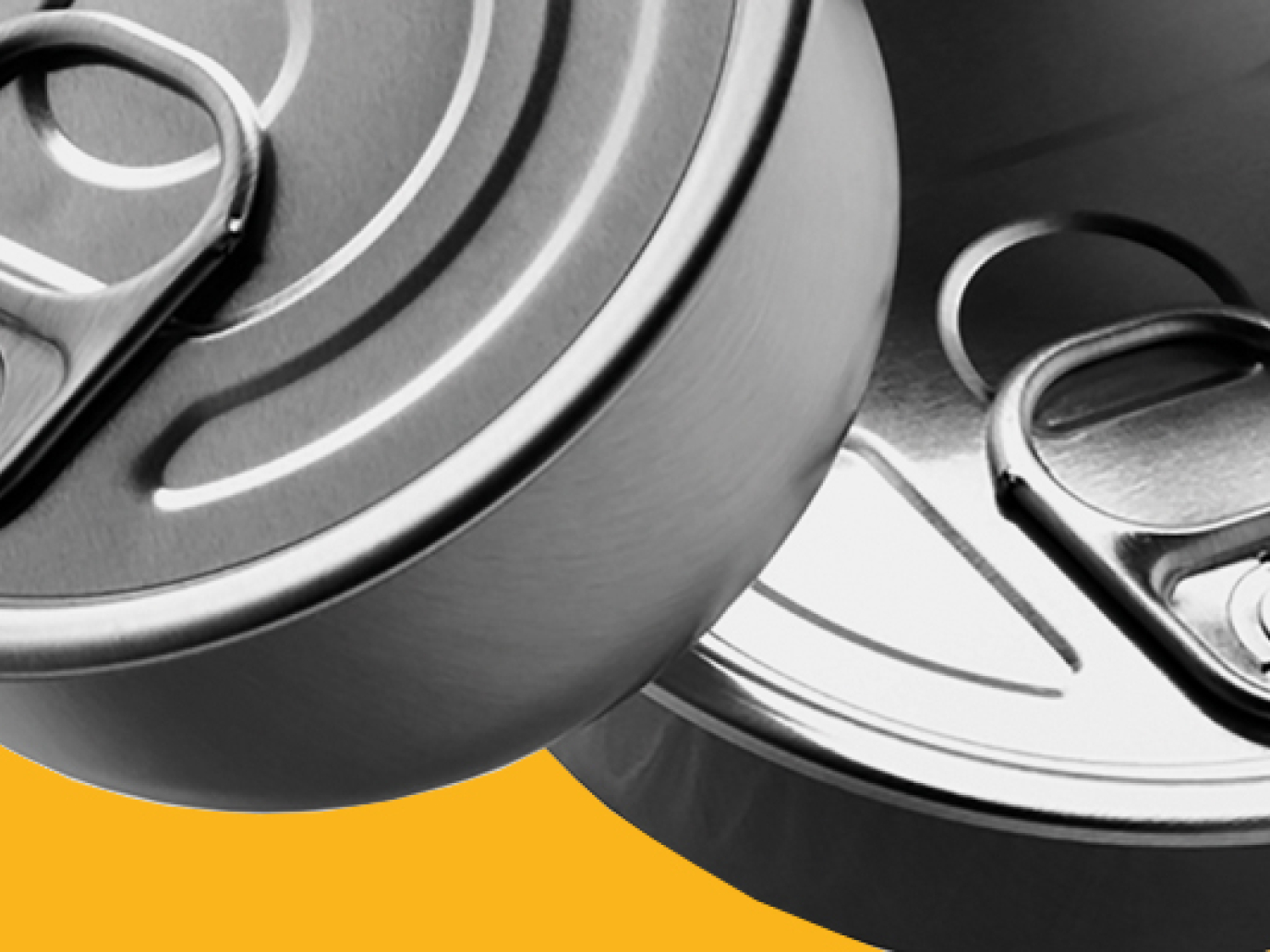Twenty years of development and growth of separate waste collection and packaging recycling that have shown constant trends, coherent with the evolution of systems and management models that have become more advanced from a planning and technological viewpoint, have enabled us to accomplish all the objectives dictated by law and the consolidation of our country’s leadership in Europe. This result is even more important if we consider the difficulties presented by waste management, in Italy, it overlapped and added on to other of our country’s typical issues – cultural, social. Political and economic scenarios and contexts vary greatly from country to country – managing to generate a unique and valuable management model for waste collection and processing, especially recycling.
This is the case for all materials within the CONAI system, but it is even more so for aluminium, by nature and vocation, it is a precursor to the principles and values that form circular economy.
A good result that underlies how all of this was possible thanks to the contribution and combined efforts of institution, businesses, municipalities, operators and citizens. Those who are now faced with new and more ambitious objectives, like those included in the recent directives on circular economy.
Italy has already surpassed the 2025 and 2030 objectives set by the circular economy directives, the former was 50% and the latter 60% recycling rate of aluminium packaging released for consumption.
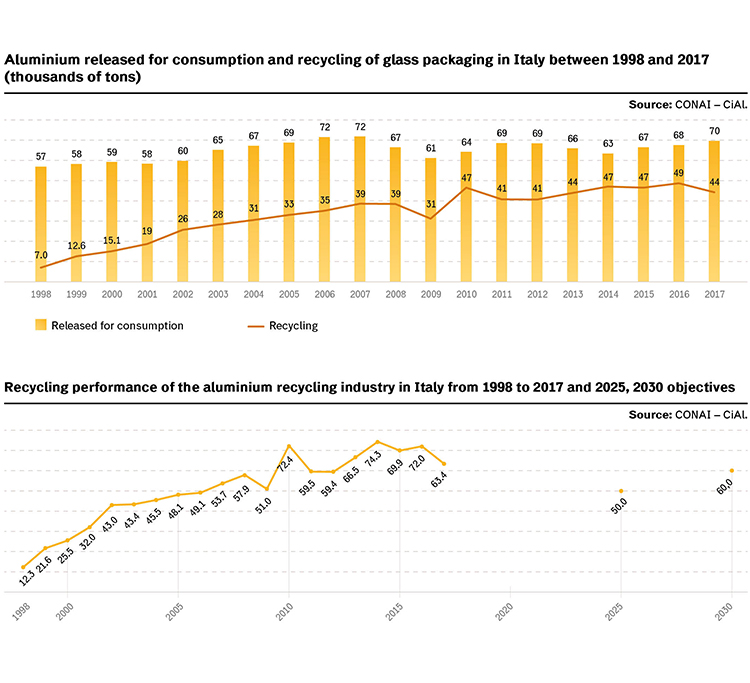
The new challenge we are faced with today is relative to quantity rather than quality, it concerns a new and innovative attitude and approach from a cultural standpoint, in order to facilitate the transition from a linear economy to a circular economy, consolidating the performances and growth trends seen in the last few years by introducing the instruments and actions necessary to determine the ordinariness and practices of a new production, consumption and energy and resource management model.
Aluminium and the economic, energy and industrial resources it represents, is able to contribute to the achievement of these great evolutionary objectives.
Current levels of material, packaging and products manufactured with said material are now especially high and important in order to advance towards our goals, with instruments and communication projects able to support and widen the awareness and participation to the great project of environmental protection that sees aluminium as the main protagonist of the new circular economy model.
Supporting separate waste collection and the support for the development of new and supplementary collection modalities aimed at a constant and continuative growth of recycling are the main objectives of the strategies and initiatives planned by the Consortium for the next three years.
The achievement of a recycling quota beyond 63% and a 68% rate of overall reuse in 2017 confirm how the national system for the management of aluminium packaging has reached levels of maturity and efficiency that can ensure further qualitative and quantitative increases in the future, especially in the areas of the country that are currently lagging behind. Optimal collection systems and models and the most advanced technologies are adopted at different stages and in different ways depending on the region, as would be expected due to the heterogeneity of the territories.
The knowledge that the development process is now irreversible, even though it is still irregular, is given by the fact that the main regions of Southern Italy are achieving interesting and growing performances, reducing the gap with other more advanced regions. On this matter, CiAl has been providing customised support for many years which is not just limited to the distribution of economic value for the material that is gathered and conferred; in fact, it mostly focuses on ensuring that the best possible options for the reuse of aluminium in the various territorial contexts are found.
Rewarding and incentivising systems correlated to the growing per capita collection quantity and quality levels, support in the adoption of new technologies and integrative waste collection solutions to ensure the uptake of material fragments that are erroneously conferred to the mixed waste section, as well as the option to reuse the aluminium fraction of the organic waste from separate waste collection facilities: these are some of the ways in which we have been operating for years in order to exploit the efforts of citizens, municipalities and operators.
Another element of satisfaction and awareness of the correctness of the actions undertaken by the Consortium is the comparison with the levels of recycling achieved by other countries in the European Union in the last few years, countries with which we often collaborate and discuss, sharing research and development projects.
An interesting aspect we must underline on this issue is that unlike other countries, the Italian system is based on the collection and reuse of all types of packaging, not only the ones that can be easily valued in economic terms. This is evidently an essential aspect that confirms our system’s ability to conjugate the economic-management efficiency to the socio-environmental responsibility we have undertaken.
Furthermore, thanks to its know how, the Consortium collaborates and complements companies in the research of solutions aimed at ensuring the environmental sustainability of products, like in the case of the exploitation of aluminium coffee pods that require dedicated actions due to their technical and distributional characteristics, or like the collection of beverage cans on the main cruise ship lines.
CiAl’s efforts are obviously collocated and coordinated with the national environmental management system and the responsibility of producers of goods and materials in the context of European and national norms with all involved subjects. On this matter, in the context of future policies and strategies with the reception of the directives, we deem it necessary to propose an action strategy on a national level in order to ensure that all areas of the territory reach the same level of efficiency, through actions that are differentiated in modality and time-frame. Following this logic, we propose the definition and divulgation of general and specific guidelines along with “traditional” legislative instruments.
Furthermore, the guidelines should include organisational, managerial and technological aspects, through the identification of replicable excellence models in order to determine adequate and coherent choices in various settings, in accordance with socio-economic characteristics, specifically those concerning the access to the “best” available technologies.
Even though some of the recommendations we have been discussing for many years seem “obvious,” they are not actually put into practice. These are the ones relative to the integrated management system of collection, processing and reuse of urban and assimilated waste; with a focus on separate waste collection systems and models that should use the same colour codes as other collection systems, regardless of the equipment (that should be aimed at an efficient and effective economic, qualitative and quantitative management in consideration of the various parameters that should inspire the organisation of services in the various territorial settings etc.).
From a strictly local point of view, we should also proceed towards a homogenisation and simplification of authorisation procedures on the national territory, in order to eliminate discrepancies in the application of laws and norms in different parts of the country, for example this could be done through an application standard of CER codes for urban and assimilated waste.
This scenario also concerns the deadline and consequent renewal of the ANCI-CONAI Framework Agreement set for the 31st of March 2019; the Consortium will work towards the review and optimisation of the contents of the Aluminium Technical Attachment, especially in economic, technical and procedural terms, in order to renew its efforts and those of the companies present in the industry.
On the issue of “environmental sustainability” of packaging and products in general, it would be appropriate to rethink communication and divulgation modalities regarding these aspects in order to avoid possible distortions of reality and obstacles for an effective development towards a green economy. I’m talking about three specific issues.
One is relative to the idea that so called degradable materials and products (with no clear classification) are actually better. As if a degradable product should be considered preferable to a recyclable and/or recycled product. The combination of characteristics, technical and environmental performances applied to a specific situation make the difference and determine the adoption of a product for a specific use. “True” information includes a wide array of materials or products with respects to their specific use under the “efficient product” umbrella. So called permanent materials like metals, and specifically aluminium with its infinite life cycle, play a very important role.
The second aspect concerns a communication problem and the distortion of reality when talking about the objectives to “create a market for the products of recycling”. This market has always existed in Italy, like in the specific case of aluminium scraps, and does not need the support of norms or laws (with the exception of some synthetic materials). The true objective is to create a greater awareness for the public on the efficient use of resources and therefore the necessity to manage said resources in an effective manner (including the end of life stage) through a more efficient separate collection process aimed at recycling and reusing materials following the principles of a more comprehensive and shared responsibility. In this case, it would be optimal to give information coordinated towards the achievement of common and shared goals for everyone involved.
The third issue is a distortion represented by what is deemed to be a superficial interpretation of the principles of prevention. In fact, it is evident that the market determines the ever increasing introduction of the values of prevention by acting in the early stages of production preventing the creation of waste (assuming that companies respect the legislative framework and follow the rules). This takes place because the cost of materials and research to modify the production system oriented towards more “eco-sustainable” solutions, company marketing choices, the orientation of the consumer/citizen are paid by the country’s economy. Therefore, the process appears to be natural and strictly bound to the company’s ability to adapt to the market. It is essential to keep focusing on the themes of prevention in order to enable the evolution of processes and products towards a green economy, but we think that it cannot be separated from what has been done and the contributions of research and technological innovations that will guarantee this irreversible process. Therefore, it is important to keep a strong focus, raise awareness, promote, monitor and evaluate with a keen eye on the specifics of various materials.
The concept of green economy and the conservation of resources is a vital part of the aluminium industry’s characteristics and values, especially what concerns the strategic importance of recycling and the consequent contribution to energy saving and the reduction of greenhouse emissions. The principles of prevention are even more important in the aluminium packaging and aluminium goods industry, with the awareness of the importance of companies and the continuous improvements brought by technological innovations that undoubtedly make our material one of the most environmentally friendly and coherent with future socio-economic policies and models and Green Economy.
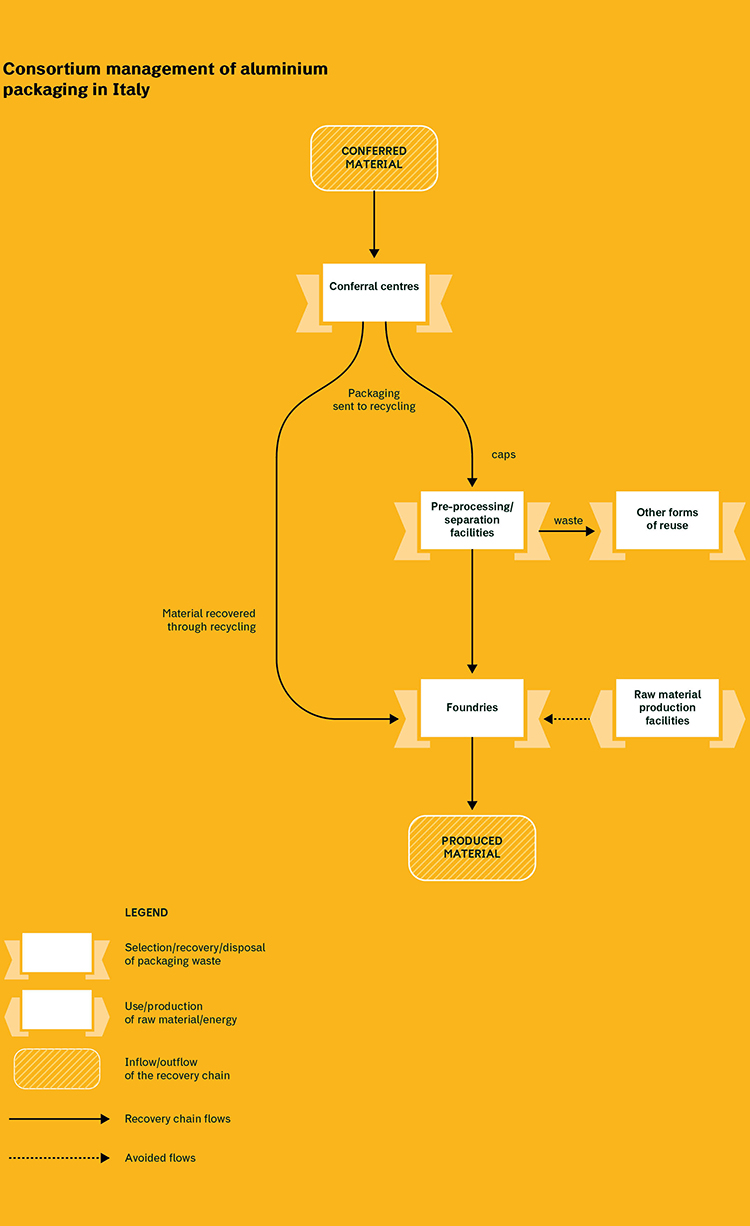
Environmental and socio economic benefits of consortium management
In 2017, CiAl recycled 14.000 tons of aluminium packaging waste, 32% of the total amount recycled on a national level.
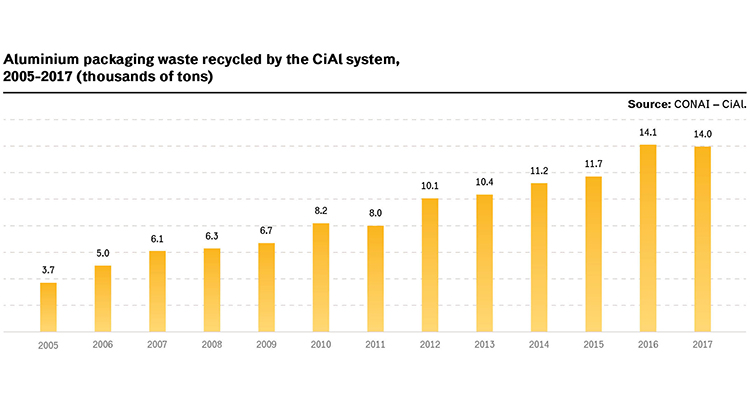
The amount of waste recycled by the consortium between 2005 and 2017 shows a constant growth rate. We can observe that the amount of recycled caps that must undergo a preparation is mostly constant, whilst there is a strong growth in the amount of aluminium packaging sent directly to foundries.
The CONAI LCC tool estimates that aluminium packaging recycling carried out by CiAl between 2005 and 2017 allowed our country to prevent the use of more than 113 million tons of raw material, the equivalent of 9 billion cans.
The trend regarding saved raw material is coherent with the development of recycled material: on the whole, the increase in material sent directly to foundries increases environmental benefits.
In 2017, the CiAl Consortium has prevented the use of 13,000 tons of raw material thanks to the recycling of aluminium packaging, 2% less compared to 2016, a decrease caused by the reduction of recycled material.
The activities carried out by the Consortium between 2005 and 2017 allowed our country to save approximately 3 TWh of primary energy, the equivalent of the energy used by 2 thermoelectric plants. Saved energy shows a trend that matches the amount of material saved until 2012, after that year, the trend is inverted and the amount of saved energy continues to increase despite a decrease in recycled material. Consequently, we can affirm that there is no direct correlation between the amount of saved raw material and saved energy. The energy consumed for unit production of raw material from fossil fuels shows an uneven development in the course of the years, since it is connected to the variations in the primary production quotas for aluminium, internal recycling and post-consumption recycling and the geographical allocation of primary aluminium.
The amount of energy saved from the recycling of aluminium packaging managed by CiAl in 2017 was 0.29 THw of equivalent primary energy, 3% less compared to 2016, but four times higher than 2005.
Atmospheric emissions avoided thanks to lower energy consumption from the use of recovered material between 2005 and 2017 are equal to 1 million tons of CO2eq, the equivalent of the emissions generated by 317,000 vehicles with an average travelled distance of 20,000 kilometres in the course of one year. In fact, the trends for greenhouse gas emission prevented for every unit of saved raw material is similar to the trends of consumed energy. Even though the trends of saved CO2 have always been variable in the course of the years, they are positive overall (avoided emissions have nearly quadrupled from 2005 to 2017).
The recycling of aluminium packaging waste carried out by the consortium has allowed to prevent the emission of 118,000 tons of CO2eq in 2017, 3% less than 2016, due to a reduction of recycled material.
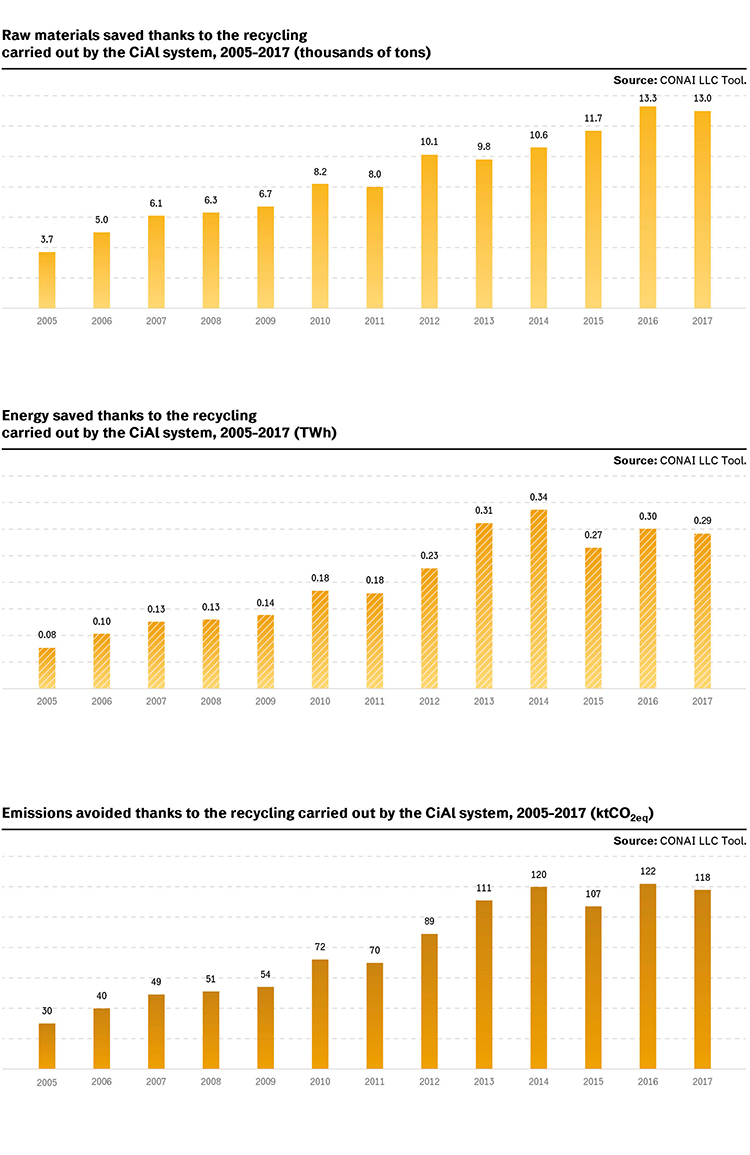
The model estimates that the environmental benefits we listed above generate an overall economic benefit of 10 million euros for 2017 (three times greater than 2005).
On the whole, the consortium aluminium packaging waste recycling industry has generated an economic value of 83 million euros. These are made up of:
- 52 million euros of direct economic benefits generated by the consortium aluminium packaging recycling industry, represented by the economic value of saved raw material; these benefits were equal to 6 million euros in 2017 (three times greater than 2005);
- 31 million euros of indirect benefits connected to CO2eq emissions avoided thanks to the consortium’s recycling activity; the total for 2017 was 4 million euros (four times greater than the estimated value for 2005).
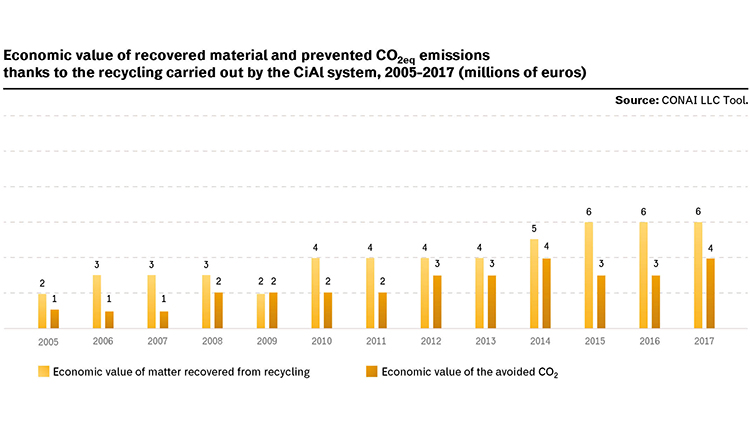
Top image – Credit: CiAl/graphic elaboration


